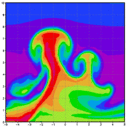Computing Across the Physics Curriculum
[an error occurred while processing this directive]
[an error occurred while processing this directive]
Mathematical Methods

You must be a registered user to access the downloads.
These modules were designed/constructed based on the text:
Mathematical Methods in the Physical Sciences, by M. Boas.
-
Geometric Series: The use of sums is very prevalent in physics. Usually, the first type of sum that students encounter is the geometric series. A typical example is its use in calculating the total distance a ball travels if it bounces to a certain fraction of the height from which it is dropped. When dealing with sums, students must be able to determine whether it is convergent, its interval of convergence, and how quickly it converges. A related question is how many terms are needed to reach a desired accuracy. This module introduces students to the geometric sum and guides them in determining its interval of convergence.
-
Riemann-Zeta Series: The Riemann-Zeta function shows up in various applications of physics, including the Stefan-Boltzmann law, Bose-Einstein condensates, and number theory. Due to its complex nature, the actual value, ζ(s), is calculated using a built-in MATLAB function. Its use here is intended to show that brute force summation does not always work.
-
Taylor Series: Taylor series approximations are very useful in physics. They are used throughout a wide array of fields, including mechanics, electricity and magnetism, statistical physics, quantum mechanics, and many others. Often, the accuracy of such an expansion as it is used throughout an interval also needs to be considered.
-
Complex Roots: Complex numbers are used throughout physics in a variety of ways. Sometimes, one is faced with the task of taking the root of a complex number. This module has students develop the skills to do this while graphically displaying their results.
-
Complex Position: Complex numbers are used throughout physics in a variety of ways. One common usage is to combine two real quantities into a single complex quantity. We can do this with position, taking two coordinates such as x and y and combining them into a complex position z. This module allows students to visualize the trajectory of a particle whose x and y positions are written in terms of a complex position which is a function of time.
-
Simultaneous Equations: The ability to solve a set of linear algebraic equations is a useful skill that finds application in a wide variety of scientific fields. This module has students develop the tools needed to solve large sets of linear equations.
-
Eigenvalues and Eigenvectors: Determining the eigenvalues and eigenvectors of a matrix finds useful application in areas that utilize linear algebra, such as classical and quantum mechanics. Often, these equations can be thought of as a mapping of points from one space to another. This module has students develop the skills to determine the eigenvalues and eigenvectors of a large (up to 6x6) matrix.
-
Directional Derivative: Gradients and dot products are among the most common mathematical tools in undergraduate physics. Being able to take a gradient of a function is a critical skill that spans many fields, including potentials that arise in gravitation and electricity problems. Directional derivatives are useful in understanding how this potential changes in a certain direction. A common example of such a problem is a hiker walking along a particular path on a mountainside.
-
Slope Field: A useful tool in the solution of a first-order differential equation is to plot the slope field. The family of solutions can be immediately inferred by inspection. Additionally, particular solutions can be generated with sets of initial conditions.
-
Skydiver: One of the first second-order differential equations encountered by students is found in the study of a particle undergoing free fall motion with a drag force. In this module, students are introduced to Newtonian drag (proportional to the square of the velocity) and Stokes drag (proportional to the velocity) through the application of a skydiver with a parachute.
-
Coupled Differential Equations: Occasionally one encounters coupled differential equations, such as in predator-prey models. In this module, students develop the skill to solve a set of coupled first-order differential equations using the MATLAB solver ODE45.
-
Pandemic: Occasionally one encounters coupled differential equations, such as in predator-prey models where two populations influence each other. In this module, students gain insight into the working of a program that models the spread of an infectious disease, similar to predator-prey models. The MATLAB solver ODE45 is implemented.
